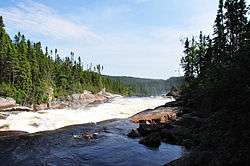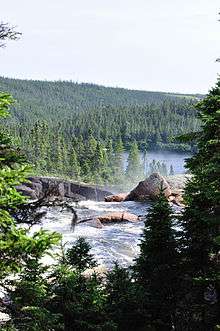Romaine River
The Romaine River is a river in the Côte-Nord region of the Canadian province of Quebec. It is 496 kilometres (308 mi) long.[1] It is not to be confused with the Olomane River that is 220 kilometres (140 mi) to the east and had the same name for a long time. It flows south into the Gulf of Saint Lawrence.
| Romaine River Rivière Romaine | |
|---|---|
 | |
| Location | |
| Country | Canada |
| Province | Quebec |
| Region | Côte-Nord |
| Physical characteristics | |
| Source | Unnamed wilderness |
| • coordinates | 52°52′20″N 63°36′55″W |
| • elevation | 685 m (2,247 ft) |
| Mouth | Gulf of Saint Lawrence |
• location | About 15 km west of Havre-Saint-Pierre |
• coordinates | 50°18′08″N 63°48′12″W |
• elevation | 0 m (0 ft) |
| Length | 496 km (308 mi)[1] |
| Basin size | 14,350 km2 (5,540 sq mi)[1] |
| Discharge | |
| • average | 340 m3/s (12,000 cu ft/s)[1] |
| Basin features | |
| Tributaries | |
| • left | Abbé Huard River |
Location
The Romaine River is about 518 kilometres (322 mi) long, none of which is in Labrador since the east bank of the river forms the border between Quebec and Labrador. The river has a Strahler number of 7.[2] It has its source on the boundary between the Atlantic and Saint Lawrence watersheds, and flows first through a series of lakes, including Long, Marc, Brûlé (Burnt), Lavoie, Anderson, and Lozeau. This portion of the river to just past the confluence with Uauahkue Patauan Creek forms the boundary between Quebec and Labrador. Then it flows in a mostly southerly direction until a dozen miles from the coast where it takes a sharp turn to the west, flowing through a series of swampy waterlogged small lakes. The Romaine River drains into the Jacques Cartier Strait, opposite the Mingan Archipelago, that is part of the Gulf of Saint Lawrence.[3]
Name
The name Romaine, in use since the end of the 19th century, is a French adaptation of the Native American term Ouraman or Ulaman as noted by Jean-Baptiste-Louis Franquelin in 1685, while Jacques-Nicolas Bellin wrote Ramane on his map of 1744. It comes from unaman, meaning "vermilion" or "red ochre". Deposits of this material are found on the banks of the Olomane River.[3][4]
Basin
The Romaine River basin covers 14,510 square kilometres (5,600 sq mi). It lies between the basins of the Mingan River to the west and the Ours River to the east.[5] About 15.5% of the basin is in Labrador north of the provincial boundary.[2] In Quebec the basin includes parts of the unorganized territory of Lac-Jérôme and the municipality of Havre-Saint-Pierre.[6] The Mine du lac Tio, an iron and titanium mine, is in the river basin.[7] It also includes the proposed Buttes du Lac aux Sauterelles biodiversity reserve.[8]
Tributaries
The significant tributaries of the Romaine River are (in upstream order):
- Puyjalon River
- Allard River
- South-East Romaine River
- Abbé-Huard River
- Garneau River
- West Garneau River
- Little Romaine River
- Touladis River
- Sauterelles River
- Rivière aux Pêchueurs
Hydroelectric development
The Romaine River is being developed by Hydro-Québec for hydro-electric power generation. Construction started in 2009 on a new hydroelectric plant, along with four rock-filled dams and a 150 kilometres (93 mi) long access road, that will take 11 years to build at an estimated cost of C$6.5 billion. Called "the biggest construction project in Canada", the project will employ an estimated 2000 people between 2012 and 2016, and create some C$3.5 billion in economic spinoffs.[9][10][11]
The final project will include four new power plants with a total installed capacity of more than 1550 MW and an average annual production of 7.5 TWh per year:[12]
This project is controversial however, as the cost of electricity production will likely be higher than the price at which the electricity will be sold, as shown in a 2010 documentary called "Chercher le courant", "Seeking The Current" in English, by Nicolas Boisclair and Alexis de Gheldère. The film argues that the Romaine project is unnecessary, unprofitable, and ecologically destructive.[13] It is also opposed by the Fondation Rivières.
| Name | Location (km from mouth) | Design flow (m3/s) | Capacity (MW) | Units | Head (m) | Est. completion year | Reservoir | Reservoir size (km2) | Geographic coord. |
|---|---|---|---|---|---|---|---|---|---|
| Romaine-1 | 52.5 | 485 | 270 | 2 | 61 | 2016 | Romaine-1 Reservoir | 12 | 50°23′01″N 63°15′37″W |
| Romaine-2 | 90.4 | 453 | 640 | 2 | 151 | 2014 | Romaine-2 Reservoir | 83 | 50°37′28″N 63°11′34″W |
| Romaine-3 | 158.6 | 372 | 395 | 2 | 116 | 2017 | Romaine-3 Reservoir | 38 | 51°06′52″N 63°24′00″W |
| Romaine-4 | 192.0 | 307 | 245 | 2 | 93 | 2020 | Romaine-4 Reservoir | 140 | 51°20′52″N 63°29′12″W |

Fauna
The Romaine River is home to the Atlantic salmon that swims 52 kilometres (32 mi) upstream as far as the Grande Chute. Other fish species are brook trout (found along the river's entire length), lake trout (in most lakes), and landlocked salmon (upstream of Grande Chute).[12]
References
- Natural Resources Canada, Atlas of Canada - Rivers
- Hydrology of the Transboundary Rivers, p. 50.
- "Rivière Romaine" (in French). Commission de toponymie du Québec. Retrieved 2010-12-21.
- "La Romaine (Réserve indienne)" (in French). Commission de toponymie du Québec. Retrieved 2010-10-04.
- Portrait préliminaire de la zone ... OBVD, p. 20.
- Portrait préliminaire de la zone ... OBVD, p. 64.
- Portrait préliminaire de la zone ... OBVD, p. 84.
- Portrait préliminaire de la zone ... OBVD, p. 90.
- "Ground broken for $6.5B hydro project on Quebec's Lower North Shore". Canadian Broadcasting Corporation. May 13, 2009. Retrieved 2010-12-21.
- "The Romaine Hydroelectric Complex - Premier Charest launches largest construction project in Canada". CNW Group. May 13, 2009. Retrieved 2010-12-21.
- "Charest launches construction of Romaine River Hydro project". The Western Star. May 14, 2009. Retrieved 2010-12-27.
- "The Romaine Complex" (PDF). Hydro-Québec. Archived from the original (PDF) on 2012-03-14. Retrieved 2010-12-22.
- Chercher le courant
Sources
- Hydrology of the Transboundary Rivers of Southern Labrador (PDF), Government of Newfoundland & Labrador, Department of Environment and Conservation, April 2013, retrieved 2019-10-15
- Portrait préliminaire de la zone de gestion intégrée de l'eau par bassin versant Duplessis (PDF) (in French), OBV Duplessis, April 2015, retrieved 2019-10-01